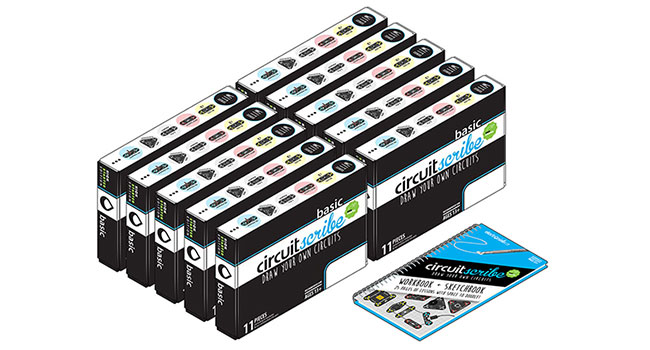Making It to '30 under 30'
Thursday, September 24, 2015

At first glance it might look like Brett Walker’s success has been as much luck as anything else. After all, the 29-year-old entrepreneur started a successful company that has enjoyed rapid growth, launched a consumer product with a wildly successful Kickstarter campaign and won recognition for his accomplishments by Forbes magazine. But crediting luck alone overlooks years of hard work, painstaking research and an education that began at Oklahoma State University.
Walker is a co-founder and CEO of Electroninks, which develops electricity conductive inks widely used in consumer electronics. But Electroninks is best known for Circuit Scribe, a rollerball pen he and colleagues invented that allows users to draw functioning electrical circuits by doodling on paper. The pen caused a sensation in 2013 when Walker launched it with a Kickstarter campaign that raised $675,000 from more than 12,000 backers, many of whom were teachers who use the pen to demonstrate how circuits work in the classroom.
“It uses a high-performance, conductive ink that’s nontoxic, dries quickly at room temperature and allows you to draw a circuit on paper and get immediate feedback if it’s working by connecting it to a battery,” Walker says.
Walker, and his company, has garnered a lot of attention in just a few short years. In 2013, Scientific American magazine named Walker’s ink one of nine materials that will change the future of manufacturing. And earlier this year, Forbes named Walker to its “30 Under 30” list in industry and manufacturing. Each year the magazine selects up-and-coming leaders under the age of 30 in a variety of fields, described as “disruptors and innovators” who are modernizing the way things are made in a greener, tech-savvy world.
Walker traces the roots of his success to OSU, where he graduated in 2004 with a bachelor’s degree with honors in mechanical engineering. The Edmond, Okla., native then went straight into a materials science engineering doctorate program at the University of Illinois at Urbana-Champaign.
As an undergrad in the College of Engineering, Architecture and Technology, Walker first experienced research and the foundations of mechanical and materials engineering that changed the course of his career. Walker says working with engineering faculty in the lab was a formative experience that led to his passion for materials science.
“There is really a lot of research going on at OSU that is widely available as long as you’re open to the experience,” he says. “As an undergrad, I got my feet wet in the practical applications in a number of areas.”
Walker worked with Dr. Jim Smay, associate professor of materials science and engineering, who was working with 3D printers to make dental composites from printed ceramic materials. He also did research with Dr. Lorenzo Cremaschi, associate professor in mechanical and aerospace engineering, assisting him with thermodynamics experiments, and mechanical and aerospace engineering professor Dr. Jamie Jacobs.
“That was it,” Walker says. “I decided this is for me. This is what I wanted to do.
“In undergrad mechanical engineering courses, I studied the failure of materials and material science and a lot of the chemical fundamentals to mechanical engineering that really interested me,” he says. “That sort of melding of mechanical engineering and the chemistry and fundamentals of materials really appealed to me and led me to do graduate work in materials science.”
Walker was also a member of the American Indian Science and Engineering Society, which he served as president his senior year, and a student scholar with the Oklahoma Louis Stokes Alliance for Minority Participation (OK-LSAMP), which supports underrepresented students studying science, technology, engineering and mathematics (STEM).
“Undergraduate research really prepared me for the research world. It was a lot of hard work but it was exciting,” Walker said.
Fueled with a passion to continue studying, Walker joined the University of Illinois research team of renowned materials engineer Dr. Jennifer Lewis and began working with conductive inks. His optimized ink improved conductivity, and the formulation was more cost-effective to manufacture and easier to use than existing products. The project, Walker’s doctoral thesis, resulted in the development of the silver-based conductive ink, which created a buzz when published in journals and highlighted in science publications. In 2012, Walker won second place in the graduate student category of the National Collegiate Inventors Competition.
The buzz resulted from a realization that this was a game changer for manufacturers of printed electronics. Most inks for printed electronics rely on suspended metal particles in the ink to conduct electricity. But the inks are expensive to make and difficult to use. Walker’s ink uses a dissolved solution of silver acetate and ammonia. Once the ink is laid down, the liquid evaporates, leaving the conductive silver behind. The ink also dries faster at lower temperatures and can be used in inexpensive printers. Walker and his fellow University of Illinois researchers knew the ink had potential to be commercialized.

In January 2013, Walker and Lewis launched Electroninks to make and market the improved conductive ink to consumer electronics manufacturers. The buzz did translate into demand as sales grew rapidly. Additional students joined the partnership to help propel an idea for a consumer product that used similar inks in a simple rollerball pen that would appeal to educators, students and DIY types interested in prototyping electronic circuitry. That pen became Circuit Scribe. Walker and his partners believed the product would be popular but had no idea how much so until the December 2013 Kickstarter campaign.
“I think it is so popular because it’s so accessible,” Walker says. “You don’t need an instruction manual for a rollerball pen. Kids who don’t know how to write yet can doodle with Circuit Scribe and make functional circuits.”
Since its launch, Circuit Scribe pens, which sell for $20, and accessories have generated more than $1.5 million in revenue. Sales of industrial inks remain the company’s largest revenue producer, but Circuit Scribe has become the “cool” face of Walker’s company.
“I feel like the educational market has the brightest future,” he said.
The company is expanding its line of pens and accessories and recently introduced Circuit Scribe in national computer and electronics chain Microcenter. Walker is pushing to see the pen sold in more retail locations and directly to educational outlets and schools.
Walker also just finished moving the company’s headquarters from Illinois to Austin, Texas, where Electroninks also develops and makes its inks. A group in Boston develops educational content, while its customer service is in Phoenix.
Walker will tell you that starting a successful business is as much about passion as it is about having a great product to sell.
“I’m passionate about learning and understanding the fundamental reasons why things work,” he says. “My experiences as an undergraduate, and in graduate school, made me realize I wanted to continue to learn and that all began with opportunities at OSU.”
For information about Walker’s company, visit www.electroninks.com.
